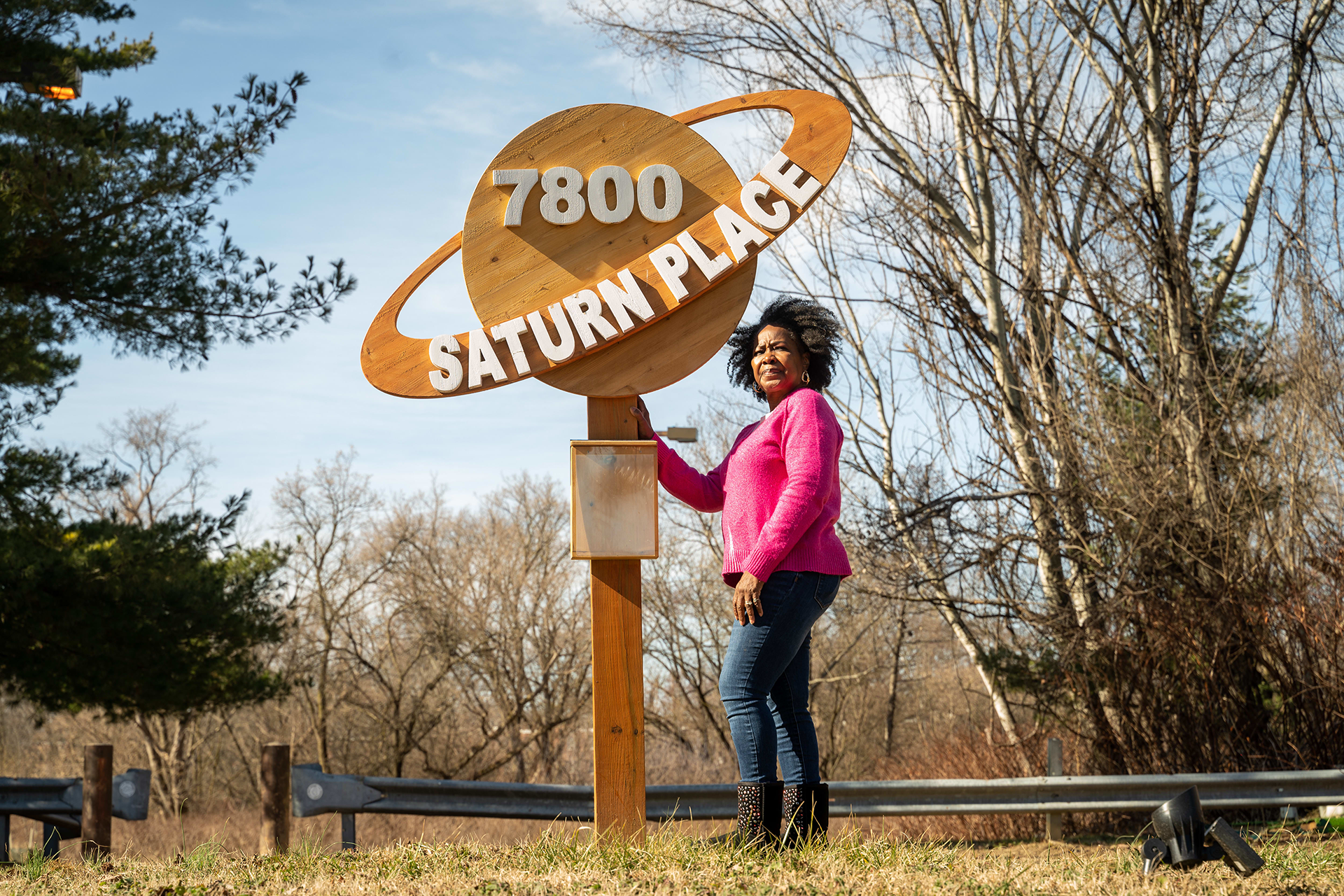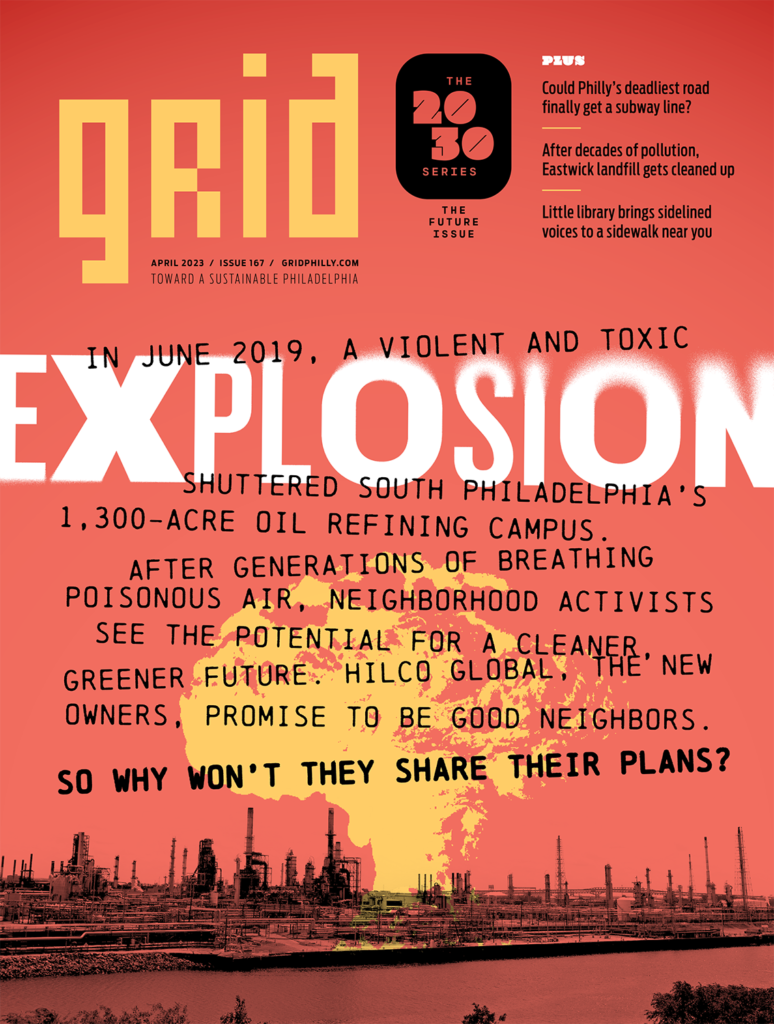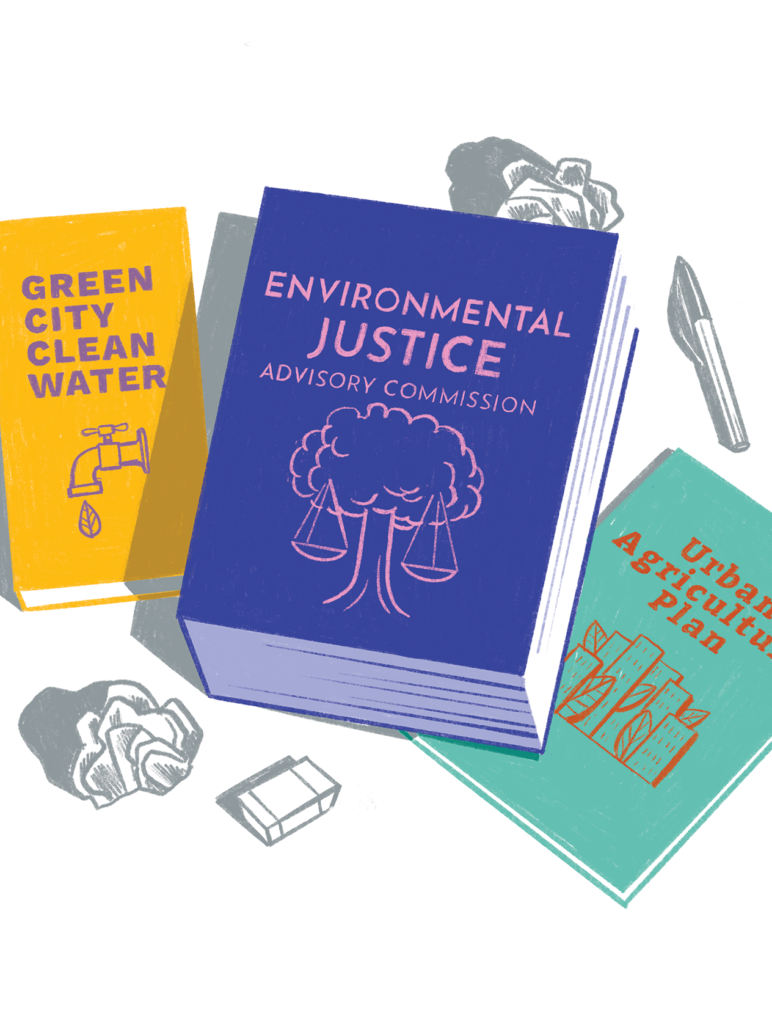Mrs. Brenda Whitfield moved to Eastwick over 40 years ago and settled in a house at the edge of the neighborhood, near the confluence of Cobbs Creek and Darby Creek. At the time she had one daughter and was expecting another. A third followed a year later. Whitfield says there were no fences to stop the kids in the neighborhood from riding their bikes up and down the Clearview Landfill, a 54-acre site that rose as a 100-foot grassy hill above the otherwise flat landscape of creek floodplain. “It was all open ground,” she says.
The landfill opened in 1953 in a much different Eastwick than the one Whitfield lives in today. “Clearview,” another name for the area, referred to the open, semi-rural community in a landscape of fields and trees. That neighborhood was essentially demolished as part of an urban renewal plan drafted in the mid-1950s. The renewal project involved elevating low-lying areas with fill (a layer of soil and debris) and then building new housing. Construction took off in the 1970s with housing built largely by the Korman Corporation.

As Eastwick’s population increased, so did complaints about the landfill. In one lurid case that landed on the pages of the Inquirer on July 25, 1968, 15-year-old Cathy Skoczen went for a walk at the landfill and came back with a dead monkey, one of about 60 of the primates killed in medical experiments and deposited at the dump. (This episode also underscores how easy it was for local kids to access the site.) Neighbors also complained about noxious sewage dumped at the landfill and rats spilling over into their properties, many of which backed up to the landfill with barely any buffer.
The landfill was finally ordered to close in 1973 and at least partly covered with soil in 1976, but neighbors continued to raise alarms about the hill of waste to the west of their homes as its toxic legacy came under federal scrutiny. In May 1984 the EPA found PCBs leaking into Darby Creek from the landfill. PCBs (short for polychlorinated biphenyls) are a group of highly carcinogenic chemicals that were used in industrial manufacturing until they were banned in the late 1970s. In spite of finding the pollution leaking from the landfill, the agency decided the site was not toxic enough to be placed on Superfund’s National Priorities List.
Pollution in Darby Creek coming from Clearview and other closed landfills spurred concerned residents living along Darby Creek to organize as the Darby Creek Valley Association in 1984, according to Jaclyn Rhoads, the group’s president. In 1985 Eastwick residents living in housing built by the developer Korman sued the Philadelphia Redevelopment Authority and Korman, arguing that neither had disclosed that the grassy hill near their houses was a dump containing hazardous waste.
Tests the EPA conducted in the late 1990s found PCBs, heavy metals and other toxic chemicals in soil, groundwater and Darby Creek. The agency collected and analyzed more samples in 1998. In September 1999 Hurricane Floyd pushed its storm surge up the Delaware River and into the rain-swollen Darby Creek, flooding the neighborhood with up to six feet of water. Residents wondered about what chemicals from the landfill might have been in the water that had soaked into their homes and yards during the storm and the decades leading up to it. In a public meeting held in 2000, 400 residents confronted EPA officials about what they saw as a cluster of cancers and other illnesses. At the time EPA officials said there was little risk to the human residents of the area, though the pollution did threaten wildlife and the marshes downstream.
After about 20 years living in the house we noticed that our neighbors were starting to be sick.”
— Brenda Whitfield, Eastwick Resident
The landfill’s neighbors were concerned that there might be a link between whatever was leaking from the landfill and the illnesses some had experienced. “After about 20 years living in the house we noticed that our neighbors were starting to be sick,” Whitfield says. She herself suspected a link between the landfill and breathing problems her grandchildren were experiencing.
In 2001 the EPA finally placed the Clearview Landfill, together with the Folcroft Landfill located in the nearby John Heinz National Wildlife Refuge at Tinicum, on Superfund’s National Priorities List. In 1980 Congress had passed the Comprehensive Environmental Response, Compensation, and Liability Act (CERCLA), commonly called “Superfund” after the fund created by the law to finance cleanups of hazardous waste sites. Communities start the Superfund process by alerting the EPA to local toxic sites. The EPA then inspects and researches the site to determine how much of a threat it poses to people and to the environment, and how urgent the threat might be. The EPA then places the worst sites on the National Priorities List, making their cleanup eligible for financing.
The listing in 2001 set wheels in motion that led to the actual cleanup activities beginning a decade later. From 2002 to 2006 the EPA researched the site, studying its history and testing soil and water on City property to understand what was contaminated and how to remediate it — a “remedial investigation” in EPA lingo. It took until 2006 to get a court order allowing the EPA to do the same on the portion of the landfill on private property. The investigation wrapped up in 2011, after which the EPA completed a feasibility study, developed a plan for the cleanup and put the plan out for public comment. In 2011–12 the EPA cleaned up toxic waste at the site that posed an immediate risk to the neighborhood. The EPA issued its Record of Decision (the final cleanup plan) in 2014, which kicked off the broader remediation project.
Today landfills are designed to keep the waste inside, protected from erosion or from precipitation that could leach out toxic chemicals (becoming what is called “leachate”) and carry them out of the landfill and into soil, groundwater and nearby waterways. Today landfills are built with an impermeable liner at the bottom, and they are capped with a nontoxic barrier.
At Clearview, by contrast, “they just dug a hole in the ground without any liners and threw stuff in. It’s clear we were not as smart as we are today,” Rhoads says.
The EPA removed contaminated soil on top of the landfill and replaced it with clean fill. Testing in the neighborhood found that soil in some of the neighbors’ backyards was also toxic. The good news, if there was any, was that the contamination didn’t cluster close to the landfill in a pattern that you would expect if floodwaters had been transporting the pollution, according to Josh Barber, remedial project manager for the EPA. Instead, that contamination was apparently due to toxic soil from the landfill having been used as fill to build up the ground in Eastwick during the construction boom of the 1970s. In any case, that soil had to go, and EPA contractors dug out the ground of 195 properties and replaced it with clean soil.
Local leaders Grid has spoken with have given the EPA high marks for involving the community in planning the cleanup through the project’s Community Advisory Group, of which Whitfield is a member. This kind of collaboration is not always the case in an environmental justice community that has seen a parade of nonprofit organizations and government agencies dropping in and promising to help, according to Whitfield. “You’re working with us and for us,” Whitfield says, “and over years working with Josh Barber it became evident we were going to become friends.” The advisory group has provided a bridge to the community, for example giving it a voice in determining the final landfill remediation plan, based on the feasible options.

The core of that remediation has focused on making sure that toxic waste remains contained within the landfill by capping it. “The goal of the cap is to prevent direct contact with what’s in there. The old way to do it was a layer of clay,” Barber says.
At Clearview the EPA has installed an “evapotranspirative” cap, which involves using plants to naturally suck up water with their roots and release it through pores in their leaves, a process called evapotranspiration. The cap also minimizes the amount of precipitation that could filter through, much as water filters through coffee grounds, though in a landfill the product is toxic leachate rather than a caffeinated beverage.
The evapotranspirative cap uses a cover of three to four feet of soil planted with trees and shrubs. Any water not sucked up by the plants will flow out through drains and into the creek before it reaches the waste within.
The EPA started its own nursery operation to source the large numbers of trees and shrubs needed to plant at the site, using space near the landfill as well as in a state game land in Lehigh County. “We knew it would be a multiyear cleanup,” Barber says. “We said, ‘Why don’t we grow our own?’”
Barber also says that the new landfill cap should be resilient in future flooding, an important consideration in a flood-prone neighborhood, a condition exacerbated as global warming raises sea levels and brings more-intense storms. The EPA has also installed a framework of logs to reinforce the banks of Darby Creek, which runs along the western side of the landfill, to keep the current from cutting into the landfill.
The above-ground Clearview Landfill remediation is the first of four phases for the entire site, including the Folcroft Landfill in the wildlife refuge and the groundwater pollution for each site. Originally slated to be finished in 2024, an injection of funding from the bipartisan infrastructure law has accelerated the remediation, and it now should be completed in 2023, Barber says.
The EPA is still working out how to deal with polluted groundwater beneath the Clearview Landfill, the result of decades of rain and snow seeping down through the waste. Possible solutions include installing pumps to remove contaminated groundwater or surrounding the site with a vertically placed barrier that Barber compared to a multilayer dip, but with materials meant to trap and neutralize waste in place of cheese, salsa and refried beans.
Although the hill will be an inviting slope to hike up and play on once the trees and other vegetation grow in, much of it will remain off limits, simply because it is private property. The East Coast Greenway will incorporate what had been a walking path through the public park at the site, bringing in cyclists who can ride down to the wildlife refuge, though Whitfield did express some wariness at what had been a quiet walking path behind her house turning into a higher-traffic multiuse path.
“It is truly a success story, and it takes a long time for these Superfund sites to go through the process,” says Rhoads. “It is due to the community pulling together and speaking with one voice and being consistent about it, educated on the issues, and, in my opinion, respectful as they communicated with EPA and other officials.”
“The community is the brightest point of light in this area,” Barber says. “They’ve put up with us digging in yards at close quarters. We weren’t always viewed as paragons of productivity, but we stuck with everybody and worked with everyone together.”
“I would rate it 100 because of the fact that it’s been done,” Whitfield says. “It’s done now. Now we can see that someone heard us and was listening to us.”









